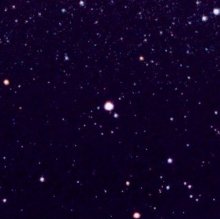
See the full-resolution image and more on polar stars in the Polar Project.
 |
Polaris (the jewel in a small semicircle of faint telescopic stars
called the "Engagement Ring") is centered in a six-degree-wide
field of view that shows a variety of other "polar stars." HR 1107
is the brighter of the two stars down toward the left hand corner.
Lamdba
Ursae Minoris is the reddish star up and to the right of
Polaris, while Yildun (Delta UMi)
is the brighter of the two stars at the upper right corner.
HR 1107 is closer to the Little Dipper in
Ursa Minor than it is to the classical figure of
Cepheus.
Roughly between Lambda and Polaris lies the North Celestial Pole,
around which they all seem to revolve.
See the full-resolution image and more on polar stars in the Polar Project. |